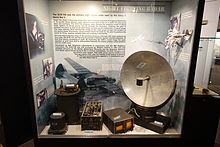 An SCR-720 displayed at the US National Electronics Museum | |
| Country of origin | United States of America |
|---|---|
| Introduced | 1944 |
| Type | Aircraft interception |
| Frequency | 3.3 GHz (S-band) |
| PRF | 1500 pps (357 for beacons) |
| Beamwidth | ~10º |
| Pulsewidth | 3⁄4 μs (2+1⁄4 μs for beacons) |
| RPM | 360 (100 for beacons) |
| Range | 375 to 50,000 ft (114–15,240 m) |
| Altitude | 500 ft (150 m) and up |
| Diameter | 29 in (74 cm) |
| Azimuth | 75º to either side |
| Elevation | 50º up, 30º down |
| Precision | 5º |
| Power | 70 kW |
| Other Names | SCR-520, SCR-517, AI Mk. X, ARI 5570 |
The SCR-720 was a World War II aircraft interception radar designed by the Radiation Laboratory (RadLab) at MIT in the United States. It was used by US Army Air Force night fighters as well as the Royal Air Force (RAF) in a slightly modified version known as Radar, Aircraft Interception, Mark X, or AI Mk. X for short.
SCR-720 was the first radar to successfully use the "helical-scan" technique, which became common in night fighter radars. The concept was first raised in early 1940 as part of UK research using the cavity magnetron as the basis of a microwave-frequency radar system. They abandoned this approach as they were unable to solve the problem of feeding microwave power to a spinning antenna. The concept was revealed to US researchers as part of the Tizard Mission during the summer of 1940, and the RadLab decided to press on with the concept. This led to the SCR-520 of 1942, designed for installation on large aircraft like the P-70 Havoc and P-61 Black Widow. Only 108 were produced, and most were later converted to the sea-search role as the SCR-517.
Western Electric started a redesign and introduced a somewhat lighter and much simpler version as the SCR-720 in late 1942. It arrived in the midst of RAF Bomber Command's efforts to introduce the "window" which proved to be equally effective on German radars as well as the RAF's own. A search for a solution led to the SCR-720 being accepted by the RAF, and window was released for use in 1943. Production versions of the Mk. X did not arrive until much later than expected, in December 1943, and did not start replacing the older AI Mk. VIII radar in front-line units until early 1944. This was just in time; the Luftwaffe began using window over the UK in January 1944 as part of their Operation Steinbock.
The SCR-720 was used by the US for only a short time as newer and longer-ranged radar systems were developed in the post-war era. The same was supposed to be true in RAF service as well, but a lengthy series of delays in various programs kept the Mk. X in service well into the 1950s. The last aircraft with Mk. X, the de Havilland Sea Vixen, remained in second-line roles until 1970.